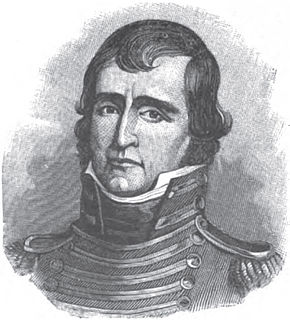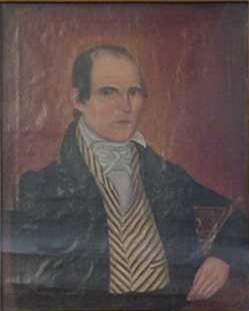Jacob Warrick (1773–November 7, 1811) was an early settler of Indiana and a militia officer.

Indiana is a U.S. state located in the Midwestern and Great Lakes regions of North America. Indiana is the 38th largest by area and the 17th most populous of the 50 United States. Its capital and largest city is Indianapolis. Indiana was admitted to the United States as the 19th U.S. state on December 11, 1816. Indiana borders Lake Michigan to the northwest, Michigan to the north, Ohio to the east, Kentucky to the south and southeast, and Illinois to the west.
Warrick was born on the then frontier at Warrick's Station, in the present-day Greenbrier County, West Virginia. He was a son of John Warrick, who had served at the 1774 Battle of Point Pleasant, during Lord Dunmore's War against the Indians. As a young man, Jacob Warrick moved to what is now Nicholas County, Kentucky.

Greenbrier County is a county in the U.S. state of West Virginia. As of the 2010 census, the population was 35,480. Its county seat is Lewisburg. The county was formed in 1778 from Botetourt and Montgomery counties in Virginia.

The Battle of Point Pleasant — known as the Battle of Kanawha in some older accounts — was the only major action of Dunmore's War. It was fought on October 10, 1774, primarily between Virginia militia and Indians from the Shawnee and Mingo tribes. Along the Ohio River near modern Point Pleasant, West Virginia, Indians under the Shawnee Chief Cornstalk attacked Virginia militia under Colonel Andrew Lewis, hoping to halt Lewis's advance into the Ohio Valley. After a long and furious battle, Cornstalk retreated. After the battle, the Virginians, along with a second force led by Lord Dunmore, the Royal Governor of Virginia, marched into the Ohio Valley and compelled Cornstalk to agree to a treaty, ending the war.

Nicholas County is a county located in the U.S. state of Kentucky. As of the 2010 census, the population was 7,135. Its county seat is Carlisle, which is also the only incorporated community in the county. Founded in 1799, the county is named for Col. George Nicholas, the "Father of the Kentucky Constitution".
In 1795 he married Jane Montgomery, a daughter of Thomas Montgomery, who had settled in today's Montgomery County, Kentucky in 1793.

Montgomery County is a county located in the U.S. state of Kentucky. As of the 2010 census, the population was 26,499. Its county seat is Mount Sterling. With regard to the sale of alcohol, it is classified as a moist county—a county in which alcohol sales are prohibited, but containing a "wet" city where package alcohol sales are allowed, in this case Mount Sterling.
The Montgomery family moved to Indiana in 1805, and Jacob Warrick joined them the following year. In 1807 Warrick and Thomas Montgomery led the militiamen that burned the last Native American village in Gibson County, pursuing the fleeing Indians into Illinois.

Native Americans, also known as American Indians, Indigenous Americans and other terms, are the indigenous peoples of the United States, except Hawaii. There are over 500 federally recognized tribes within the US, about half of which are associated with Indian reservations. The term "American Indian" excludes Native Hawaiians and some Alaska Natives, while Native Americans are American Indians, plus Alaska Natives of all ethnicities. Native Hawaiians are not counted as Native Americans by the US Census, instead being included in the Census grouping of "Native Hawaiian and other Pacific Islander".
As a militia captain, Jacob Warrick commanded an Indiana company during Tecumseh's War. He was killed in 1811 at the Battle of Tippecanoe. His widow survived him by 35 years. [1]

Tecumseh's War or Tecumseh's Rebellion was a conflict between the United States and an American Indian confederacy led by the Shawnee leader Tecumseh in the Indiana Territory. Although the war is often considered to have climaxed with William Henry Harrison's victory at the Battle of Tippecanoe in 1811, Tecumseh's War essentially continued into the War of 1812, and is frequently considered a part of that larger struggle. The war lasted for two more years, until the fall of 1813, when Tecumseh, as well as his second-in-command, Roundhead, died fighting Harrison's Army of the Northwest at the Battle of the Thames in Upper Canada, near present-day Chatham, Ontario, and his confederacy disintegrated. Tecumseh's War is viewed by some academic historians as being the final conflict of a longer term military struggle for control of the Great Lakes region of North America, encompassing a number of wars over several generations, referred to as the Sixty Years' War.

The Battle of Tippecanoe was fought on November 7, 1811 in Battle Ground, Indiana between American forces led by Governor William Henry Harrison of the Indiana Territory and Indian forces associated with Shawnee leader Tecumseh and his brother Tenskwatawa, leaders of a confederacy of various tribes who opposed settlement of the American West. As tensions and violence increased, Governor Harrison marched with an army of about 1,000 men to disperse the confederacy's headquarters at Prophetstown, near the confluence of the Tippecanoe River and the Wabash River.
Warrick County, Indiana is named for Jacob Warrick.

Warrick County is a county located in the U.S. state of Indiana. As of 2010, the population was 59,689. The county seat is Boonville. It was organized in 1813 and was named for Captain Jacob Warrick, an Indiana militia company commander killed in the Battle of Tippecanoe in 1811. It is one of the ten fastest-growing counties in Indiana.









